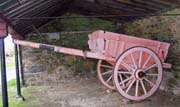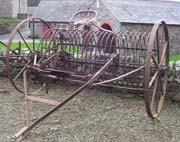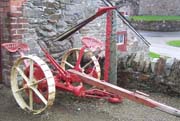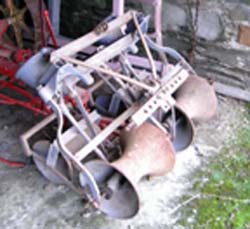When early man
progressed from a lifestyle as a hunter gatherer and adopted an
agricultural way of life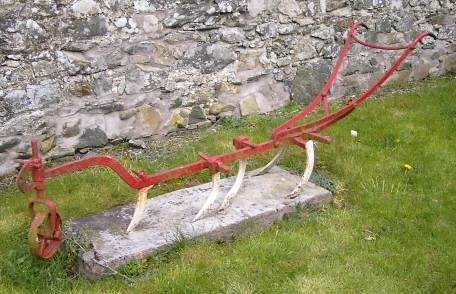 he would have needed some way to break up the earth to plant seeds,
he may have used slash and burn, as an easy means to clear the
land, planting the seeds in the scorched earth between the tree
stumps.
he would have needed some way to break up the earth to plant seeds,
he may have used slash and burn, as an easy means to clear the
land, planting the seeds in the scorched earth between the tree
stumps.
It probably wasn't long before he realized
the superior physical strength of cattle could be utilized to
pull a plough, which would have been a stout tree branch. Exactly
when the plough came into use and whether or not it was was fitted
with a share or point, is not known, the practicalities of attaching
a flint or stone point to a wooden object pulled through the ground
seem rather daunting.
With the advent of the Bronze Age about
1700 BC man had learned to cast copper and tin into almost any
shape he desired, this metal would have probably been considered
to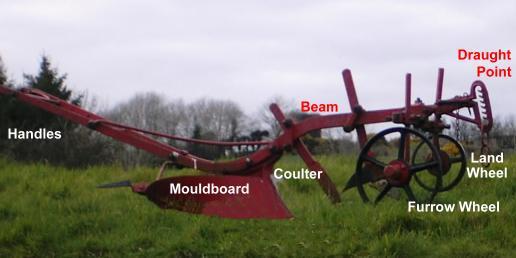 precious to be used for such a mundane task as ploughing, particularly
so when it would have worn away and been lost, although it was
almost certainly used for sycles and scythes.
precious to be used for such a mundane task as ploughing, particularly
so when it would have worn away and been lost, although it was
almost certainly used for sycles and scythes.
Over one thousand years passed before the
secrets of smelting iron was discovered. This was a very significant
step in mans development, enabling him to produce articles of
strength and durability hitherto only dreamed of, small wonder
the early smiths were venerated and credited with almost mystical
powers. As with bronze the early iron would have been available
only in small quantities and it may have been some 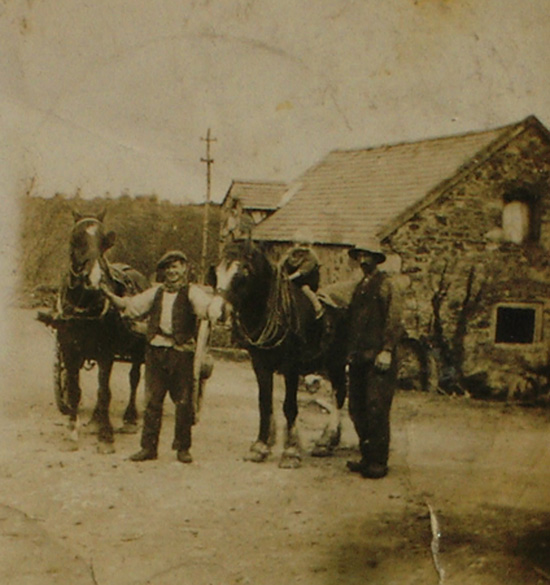 considerable
time before it found its way into agriculture. considerable
time before it found its way into agriculture.
The majority of small farms would not have
been able to afford a horse, the spade was used to work the land
and feed their families. Although some formed themselves into
unofficial groups sharing a horse and helping each other during
planting and harvest, this system found favour in the west of
the country, it was called Rundale.
A group of people involved in the agricultural scene was the 'spalpeens'
these were labourer's who traveled the country with a spade or
scythe offering their services to farmers or landowners.
In earlier times the spade was  made
by the local blacksmith, communities then were more or less self
sufficient each town or village having craftsmen catering for
the needs of the locality. This is probably the main reason for
the diversity of spade types seen across Ireland, although the
soil type had a bearing on this also, Mayo and the western counties
favoring a narrower blade for their stony soil. made
by the local blacksmith, communities then were more or less self
sufficient each town or village having craftsmen catering for
the needs of the locality. This is probably the main reason for
the diversity of spade types seen across Ireland, although the
soil type had a bearing on this also, Mayo and the western counties
favoring a narrower blade for their stony soil.
With the advent of the industrial
revolution in Ireland a few spade mill's were set up across the
country producing spades and other farm implements, many of these
were water
powered, one such was Patterson's
Spade Mill in County Antrim. |


 he would have needed some way to break up the earth to plant seeds,
he may have used slash and burn, as an easy means to clear the
land, planting the seeds in the scorched earth between the tree
stumps.
he would have needed some way to break up the earth to plant seeds,
he may have used slash and burn, as an easy means to clear the
land, planting the seeds in the scorched earth between the tree
stumps. precious to be used for such a mundane task as ploughing, particularly
so when it would have worn away and been lost, although it was
almost certainly used for sycles and scythes.
precious to be used for such a mundane task as ploughing, particularly
so when it would have worn away and been lost, although it was
almost certainly used for sycles and scythes. considerable
time before it found its way into agriculture.
considerable
time before it found its way into agriculture.
